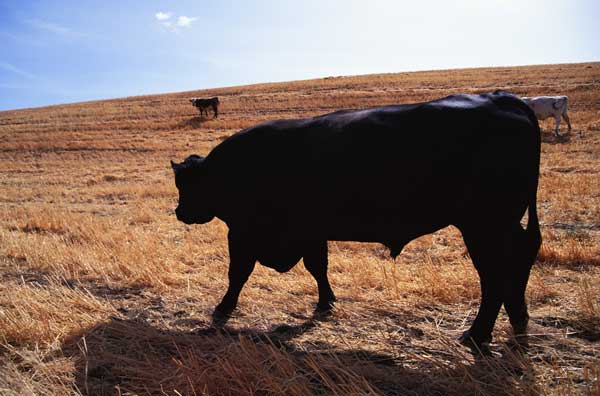
The Pasture, Rangeland and Forage (PRF) program protects livestock producers from losses to productivity caused by poor forage conditions.The decision to purchase PRF must be based on an analysis between the historical results as compared to a producer’s results.The Livestock Risk Protection (LRP) program and the Livestock Gross Margin (LGM) program both protect against price fluctuations.

Cattlemen and other livestock producers have several new risk management products available that will help with loss of production and declining prices.
The Pasture, Rangeland and Forage (PRF) program protects livestock producers from losses to productivity caused by poor forage conditions. The Livestock Risk Protection (LRP) program and the Livestock Gross Margin (LGM) program both protect against price fluctuations.
Bill Murphy, administrator of the USDA Risk Management Agency explained the programs at a recent Beef Financial Management Conference in Amarillo.
In 2011, Texas livestock producers bought 5,633 PRF policies on 21,900,291 acres of forage land. Nationally, producers bought 13,237 policies on 34,109,603 acres. “The program was very popular in Texas,” Murphy said.
Texas producers bought 19 LRP policies for 1,474 head of cattle. Figures nationally were 1,460 policies on 209,755 head. Only 1 LGM policy was sold in Texas on 300 head of cattle. Nationally, that program totaled only 8 policies and 1,480 head of cattle.
Murphy said the PRF program is “an area plan only. Losses cover an area called a grid and it is not individual coverage and does not measure actual individual production.”
PRF is based on an index. Deviation from normal/historical levels of either rainfall or vegetation—depending on the program available—provides the basis for payment.
“Payments are made on a timely basis,” Murphy said. “And this program does not reward poor management practices and the producer cannot influence the outcome or losses.”
In Texas, Oklahoma, and Kansas (among other states) the program is based on a rainfall index. If rainfall is lower than the norm during the insured period, the insured producer may collect indemnity. In New Mexico and Arizona (and several other states), payment is based on a vegetative index. If vegetation is lower than the norm during the insured period, the insured may collect.
Murphy said the rainfall index is based on NOAA Climate Prediction Center data. “It uses multiple point data, not a single point system. Deviation from normal includes 1948 to the present.
“Lack or precipitation is the only cause of loss,” Murphy said. “Review of historical data is critical.”
The vegetative index “utilizes satellite remote sensing data to determine deviation from normal: 1989 to present. “Again, review of historical indices is critical,” he said.
The system measures photosynthesis, not forage height, to determine deviation and measures all vegetation/biomass located within the grid. That includes forage, weeds, trees and flowers.
Murphy said producers should look at historical indices (available on a USDA website) to determine if past results track with what producers have observed and if production trends follow those historical numbers.
He said changes in cropping patterns and production practices may alter the vegetative index data. “Producers must spend time reviewing the historical data and comparing that to past production.”
Producers may select certain index intervals(certain months) to insure, so knowing when deviations from norm are most likely will make decision-making much easier and more accurate. “The basis of the decision to purchase must be based on an analysis between the historical results as compared to a producer’s results,” Murphy said.
He said the results may not track 100 percent all the time.
Price risk management
The LRP is owned and maintained by Applied Analytics Group, Murphy explained, and insures against price declines for fed and feeder cattle. It does not consider casualty or death losses.
“Actual ending values are based on weighted average prices as reported in the Chicago Mercantile Exchange Group Feeder Cattle Index.”
Length of coverage may be 13, 17, 21, 26, 30, 34, 39, 43, 47 or 52 weeks. Producers may select coverage ranging from 70 percent to 100 percent of the expected ending value.
“If the ending value is below the coverage price, the producer will be paid an indemnity for the difference between the coverage price and the actual ending value.”
Murphy said the LGM program is owned and maintained by Iowa Agricultural insurance Innovations LLC.
“LGM is a bundled option of Chicago Mercantile Exchange contracts that covers both livestock price and feed costs (Asian Option),” he said. Coverage includes lean hogs, cattle and dairy cattle.
“For cattle, LGM protects against loss of gross margin—market value of livestock minus feeder cattle and feed costs,” he explained.
“Indemnity at the end of 11-month insurance period is the difference, if positive, between gross margin guarantee and actual gross margin. It does not insure against loss due to death or damage to cattle.”
The program uses futures prices to determine expected gross margins and the actual gross margin. “The producer’s actual price is not used,” Murphy said. The price the producer receives at the local market is not used in any calculations.
“Policies are sold on the last business Friday of the month until 8 p.m. Central Standard Time the following day. Producers can sign up for LGM twelve times per year and insure all the cattle they expect to market over a rolling 11-month insurance period,” Murphy said. “The policy can be tailored to any size farm.”
LGM is an alternative to producers buying options on their own. “Options cover fixed amounts of commodities and those amounts may be too large to be used in the risk management portfolio of some farms,” Murphy said.
The program is available in Texas, Oklahoma, Kansas and several mostly Midwestern states.
About the Author(s)
You May Also Like





